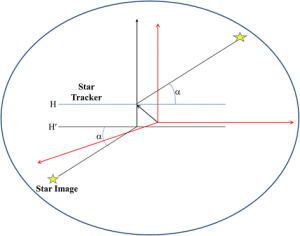The development and implementation of star tracker algorithms have revolutionized spacecraft navigation by enabling precise attitude determination. These algorithms are integral to the functionality of star trackers, which use star positions to maintain and adjust the orientation of satellites and other space-bound vehicles. This article delves into the intricacies of star tracker algorithms, their importance, and the advancements that have enhanced their performance.

Understanding Star Tracker Algorithms
Star tracker algorithms are sophisticated software routines that process the images captured by star trackers. The primary goal of these algorithms is to identify stars in the captured images, match them with a preloaded star catalog, and determine the spacecraft’s orientation based on this information. The efficiency and accuracy of these algorithms are critical for the overall performance of the star tracker.
Core Functions of Star Tracker Algorithms
Star tracker algorithms perform several key functions that are essential for accurate attitude determination:
- Star Detection: The first step involves detecting stars in the images captured by the star tracker’s optical system. This requires distinguishing star points from background noise and other celestial objects.
- Pattern Recognition: Once the stars are detected, the algorithm identifies patterns formed by the stars. This pattern recognition is crucial for matching the observed star field with the star catalog.
- Star Catalog Matching: The algorithm compares the detected star patterns with the preloaded star catalog. This step involves complex computations to ensure accurate matching, considering factors like star brightness and positions.
- Attitude Calculation: Based on the matched star patterns, the algorithm calculates the spacecraft’s orientation in space. This involves determining the precise angles relative to known reference frames.
Advancements in Star Tracker Algorithms
Recent advancements have significantly enhanced the capabilities of star tracker algorithms. These innovations include:
- Improved Sensor Technology: Modern sensors, such as advanced CCD and CMOS sensors, provide higher resolution and better sensitivity, allowing the algorithms to detect fainter stars and achieve higher accuracy.
- Enhanced Computational Power: Increased onboard computational power enables the implementation of more complex and sophisticated algorithms, improving the speed and accuracy of attitude determination.
- Machine Learning and AI: Integrating machine learning and artificial intelligence into star tracker algorithms allows for adaptive learning and improved pattern recognition, enhancing the robustness and reliability of the system.
Applications of Star Tracker Algorithms
Star tracker algorithms are critical in various space mission applications:
- Earth Observation: Accurate orientation is essential for Earth observation satellites to capture high-resolution images and data for environmental monitoring, disaster management, and resource exploration.
- Scientific Missions: Space telescopes and scientific instruments rely on precise pointing to observe distant celestial objects and gather valuable data for research and exploration.
- Navigation and Communication: Communication satellites and navigational spacecraft require stable and accurate orientation to maintain communication links and ensure reliable data transmission.
Challenges and Future Directions
While significant progress has been made, star tracker algorithms still face challenges that need to be addressed:
- Space Debris and Light Pollution: The presence of space debris and light pollution can interfere with star detection, necessitating robust algorithms that can filter out such noise.
- Thermal Variations: Changes in temperature can affect the performance of optical components and sensors, requiring algorithms that can compensate for these variations to maintain accuracy.
- Autonomous Operations: As space missions become more complex and long-duration, there is a growing need for algorithms that can operate autonomously, making real-time adjustments and corrections without human intervention.
Future directions in star tracker algorithm development focus on enhancing their robustness, accuracy, and adaptability. Research is ongoing to develop algorithms that can better handle dynamic and challenging space environments, ensuring reliable performance across various mission scenarios.
In summary, star tracker algorithms play a vital role in ensuring the accurate orientation of spacecraft, which is crucial for the success of space missions. With continuous advancements in sensor technology, computational power, and AI integration, these algorithms are becoming increasingly sophisticated, offering enhanced performance and reliability. Understanding and improving star tracker algorithms will continue to be a key focus in the pursuit of more precise and efficient space navigation technologies.
![]()